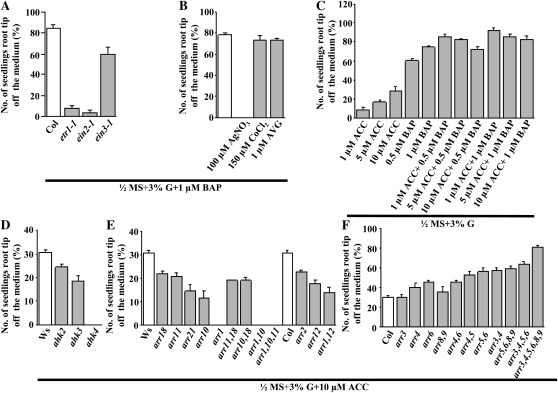Figure 5.
The role of ethylene signaling and biosynthesis in controlling the CK-induced root growth response. Wild-type and mutant seeds were sown on treatment medium and grown vertically in the light. The data presented are averages of three biological replicates, with each replicate having 30 seedlings and error bars representing sd. A, Comparison of the CK-induced root growth response of 7-d-old Col and ethylene receptor and signaling mutant seedling roots. Col and mutant seeds were sown on 3% G + 1 μm BAP-containing half-strength MS medium. Ethylene receptor mutant etr1-1 and signaling mutant ein2-1 showed reduced CK-induced root growth responses, while the response of ein3-1 was only a little less as compared with the wild type. B, Comparison of the CK-induced root growth response of 7-d-old Col in 3% G + 1 μm BAP-containing half-strength MS medium in the presence of an ethylene signaling inhibitor (AgNO3) and biosynthesis inhibitors (CoCl2 and AVG). The CK-induced root growth was completely abolished in the presence of AgNO3, while no significant reduction was found in the presence of CoCl2 or AVG. C, Comparison of the CK-induced root growth response of 8-d-old Col in 3% G + BAP- and/or ACC-containing half-strength MS medium. Supplementing ACC and BAP together enhanced CK-induced root growth. D to F, Comparison of the CK-induced root growth responses of 7-d-old wild-type and different CK signaling mutant seedling roots in ACC-containing medium. Wild-type and mutant seeds were sown on 3% G + 10 μm ACC-containing half-strength MS medium. The response was reduced in the CK receptor and type B ARR mutants and significantly enhanced in type A ARR multiple mutants. Student’s t test, P < 0.05, n = 3 biological replicates.

